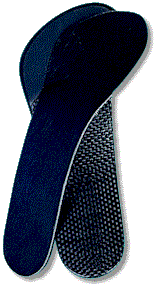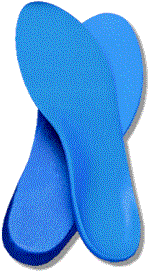Foot Orthotics We Offer
We are proud to offer our patients a selection of high-quality foot orthotics to meet their needs.
Rigid Graphite Orthotic
 These devices are made of TL-2100 Graphite fiber, have rigid biomechanical control, simulated leather cover to metatarsal heads, are thin and lightweight, and have firm crepe rear foot posts. This orthotic fits most men’s dress shoes, and in almost all men’s and women’s athletic shoes. They are the thinnest.
These devices are made of TL-2100 Graphite fiber, have rigid biomechanical control, simulated leather cover to metatarsal heads, are thin and lightweight, and have firm crepe rear foot posts. This orthotic fits most men’s dress shoes, and in almost all men’s and women’s athletic shoes. They are the thinnest.
They generally do not fit in women’s dress shoes. (For women’s dress shoes, we recommend the Dress Orthotic.)
Sport Orthotic
 This orthotic is for athletes and other active people who need superior biomechanical control to establish superior foot and leg function. It helps prevent injury by protecting against pressure and impact shock.
This orthotic is for athletes and other active people who need superior biomechanical control to establish superior foot and leg function. It helps prevent injury by protecting against pressure and impact shock.
Sport Orthotics include an aerated 1/8″ soft top cover, heel pad, and heel cup. They are more flexible than the Rigid Orthotics, but still provide excellent foot control.
The Sport Orthotic has an optional full length top cover. The full length top cover takes up more space in the shoe.
These devices are designed to accommodate the special requirements of sports activities for both men and women. They come with an aerated padded top cover to reduce the effects of foot perspiration and act as a soft tissue supplement providing padding and comfort, a heel pad for additional shock absorption upon heel strike, and heel cup for calcaneal stabilization. These orthotics provide maximum support during sports activities.
Recommended for use in athletic shoes. They can also be configured to fit ski boots.
Dress Orthotic
 This is a thin and narrow semi-rigid orthotic. It is best used in women’s dress shoes with a moderate heel. It provides relief for postural back pain and foot or leg pain.
This is a thin and narrow semi-rigid orthotic. It is best used in women’s dress shoes with a moderate heel. It provides relief for postural back pain and foot or leg pain.
Dress Orthotics are available in 3/4 length, with a graphite fiber shell and vinyl top cover. The metatarsal head area is padded for comfort.
These devices are 3/4 length to provide better shoe fit and are narrow cut for slimmer shoe counters. They will fit into women’s shoes with a 1 to 3 inch heel. These are designed for patients who require and can tolerate firm support but wear hard to fit shoes.
Designed for narrow loafers, dress shoes, women’s flats, and high heels.
Protection Orthotic
 This orthotic is designed for patients who require protection and accommodation. It works especially well for patients with diabetes, desensitized feet, or arthritic conditions. It affords less correction but more cushioning.
This orthotic is designed for patients who require protection and accommodation. It works especially well for patients with diabetes, desensitized feet, or arthritic conditions. It affords less correction but more cushioning.
Protection Orthotics are full length orthotics, that come with a soft top cover, metatarsal and cuboid corrections, a cushioned bottom layer, and heel pad.
These devices are for both men and women who can only tolerate minimal support. This orthotic is designed strictly for accommodative purposes. It is very soft and flexible. The padded top cover molds to the patients foot to accommodate plantar prominences and is a soft tissue supplement providing padding and comfort. Softer corrections throughout the support provide forgiving foot support, a heel pad for additional shock absorption, and soft bottom layer for increased padding and comfort.
Comfortable, roomy shoes are recommended as these orthotics are slightly bulky because of the soft materials used in the fabrication.
Frequently Asked Questions
Orthotics are custom-made inserts that fit inside the shoe. They are designed to decrease abnormal motion of the foot while allowing for normal movement. They realign the foot to a more usual or “neutral” position, restore balance, improve sports performance and serve to eliminate or reduce foot, back and leg pain by improving function and efficiency. There are several styles which can be worn comfortably in most types of shoes.
Orthotics benefit people with foot pain or discomfort due to imbalance. Some imbalances are obvious, such as flat feet, excessive pronation, bow legs, knock knees, pigeon-toes, “duck feet” or high-arched feet. However, many foot deformities are subtle, and are not detected until symptoms occur.
People who must walk or stand excessively at their work will also benefit from the comfort of orthotics.
For those who are active in sports, orthotics will often increase endurance, performance and strength.
For overweight individuals, orthotics will help to counteract the extra stress on the feet. Small problems are often magnified due to the increased weight.
Orthotics will benefit people with special needs, such as diabetics or the elderly. These individuals need accommodation or increased softness in the orthotic. Orthotics can work in a preventative manner to avoid the development of future foot problems, such as skin ulcerations.
If you have arch pain, heel pain, plantar fasciitis, tendonitis, shin splints, calluses, corns, bunions, or hammer toes, cramping, aching or tired legs, you can achieve an improvement. Certain types of leg, lower back and neck pain can be alleviated. The support that is provided helps control excessive pronation and helps with mid-foot, heel, ankle, knee, hip, and lower back pain. If you have a neuroma, geriatric, or diabetic foot problem, orthotics can provide you with needed protection and comfort.
Imbalance in your feet can distort the skeletal architecture of your body. While foot orthotics will not make a marked improvement in posture, they may eliminate posture problems or pain caused by your feet.
These articles can help you decide if your foot problem can be helped by using orthotics.
Although the human body is an amazing structure, it does have some design problems. It is intended to support and balance a large, tall and often heavy structure, on two very small surfaces. The force through a foot during normal walking is enormous. This force is increased greatly during sports activities. Imbalances of the bones of the feet can result in abnormal foot motion. This can impair foot function which can result in abnormal rotation of the legs, and sometimes affect the knees, hips or back. If we combine these tremendous forces with the need for precise balance, we can see how small structural changes in the foot can make significant differences. Orthotics help to improve those structural changes.
Orthotics are particularly effective in relieving the fatigue and discomfort associated with “aging” feet. Years of walking and standing often cause the development of arthritis within the foot.
Arch supports merely push against the arch when you are standing, and are not designed with the dynamic needs of your foot in mind. Although a $15.00 arch support can be of some help, they are very limited, and are manufactured in bulk to fit an “average foot” (whatever that is).
Just like eyeglasses must be designed to meet the specific needs of your eyes, orthotics must be designed to treat the unique requirements of your feet.
No. Orthotics simply allow the muscles, tendons and bones of the feet and lower legs to function at their highest potential.
Your individual foot structure is captured in foot mold or impression. The orthotics are then fabricated, using these measurements, by a state-of-the-art computerized equipment, based upon your requirements. They are made from a variety of materials, depending upon your specific condition, activities, occupation, physical stature and the types of shoes in which you will be wearing them.
Sports activities result in unusually high amounts of movement and pressure on the foot. Slight imbalances in the foot not dangerous or detectable under everyday circumstances may render you vulnerable to injury with the extra stress of sports activity. By eliminating the need for your muscles to compensate for these “hidden” imbalances, orthotics reduce fatigue and promote the kind of efficient “muscle memory” that’s crucial to outstanding performance. Orthotics help absorb these pressures, and can reduce abnormal rotation and side-to-side movement. Walkers, runners, rollerbladers/skaters, tennis players, cyclists, skiers, baseball players, soccer players, or anyone who engages in sports will benefit.
It is important to note that by aiding foot control or movement, orthotics not only improve the function of the feet, but also of the legs and torso as well. Often the difference is noted immediately.
You may find that your orthotics will be comfortable right away, or you may need a few days to get used to them. When you first begin to wear orthotics, your feet will experience subtle, yet distinct changes. Like shoes that you wear for the first time, there is a normal break-in period.
